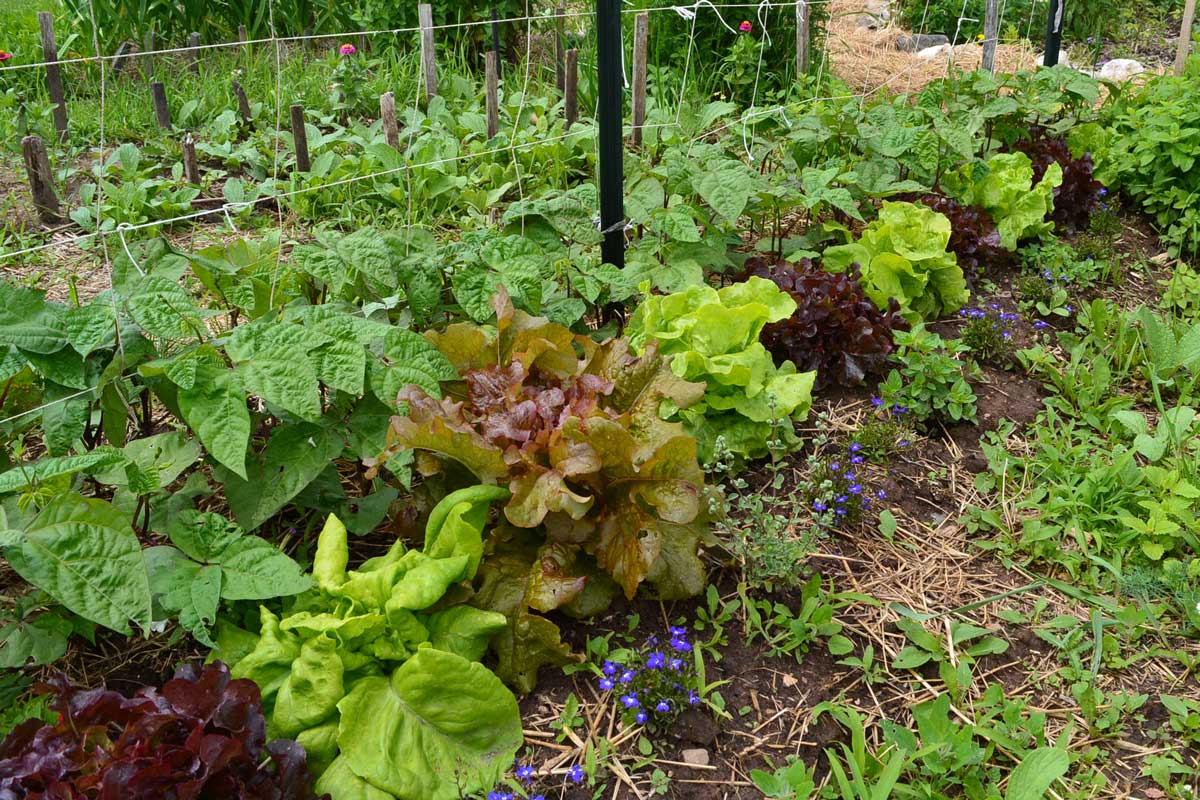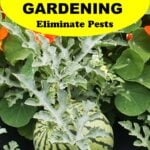Save Money and Eliminate Pests with Regenerative Gardening
This post may contain affiliate links. Read my full disclosure here.
There are many different gardening terms flying around, but I hope the term “regenerative gardening” is here to stay. We’ll explain what regenerative gardening is and why you want to use it to create your best home garden ever.

Table of contents
What is Regenerative Gardening?
Regenerative gardening aims to rehabilitate and enhance the entire ecosystem of the garden. It emphasizes practices that build soil health, promote biodiversity, and increase resilience to pests and diseases. Food grown this way tastes better and packs more nutrition (it also lasts longer after harvest).
Like regenerative agriculture, regenerative gardening reduces or eliminates outside inputs such as synthetic fertilizers. Instead, we work with the plants and soil life, and favor locally sourced amendments. This can dramatically reduce costs, improve soil health, and close the waste gap.
For instance, instead of buying a bag of calcium nitrate, we can create our own supplement from egg shells or bones. Use homemade apple scrap vinegar to make a vinegar extraction, then dilute the extraction to feed your plants and soil. (You can use purchased vinegar if you don’t have homemade, but it’s handy to put those scraps to use.)
Some of the techniques such as composting, mulching, crop rotation, and cover crops will be familiar to organic growers. Other tools, like creating local mineral extractions based on soil testing and working with structured water, may be new.
How Does Regenerative Gardening Differ from Conventional Gardening?
First, I’d like to note that growing your own food on any scale is a step in the right direction. Even a small garden provides fresher food, and reduces food miles (the distance from harvest to table). This growing method is simply “digging deeper” into the health of whole system.
Soil Health
Conventional gardening often relies on chemical fertilizers and pesticides. These can degrade soil structure and reduce its fertility over time.
Regenerative gardening focuses on building healthy soil through organic matter addition, minimal tilling, and natural amendments. This gives natural plant allies – soil bacteria, fungi, and other organisms – the conditions they need to thrive.
Healthy soil life and plants can also break down and eliminate (remediate) toxins in the soil. In his book, Regenerative Soil, Matt Powers outlines strategies for remediating toxins from lead to glyphosate. We have the power to help our gardens heal contamination.
It’s not carbon dioxide that’s a threat, it’s the microplastics, heavy metals, and “forever chemicals”. Regeneration includes remediation.
Biodiversity
Conventional gardens often feature monocultures or limited plant varieties. This makes them more susceptible to pests and diseases. We’ve all seen gardens with single rows of plants divided by barren strips of well tilled soil. Pests show up and work their way through all the plants, and there’s not much habitat for beneficial insects.
Regenerative gardens incorporate a wide range of plants, including native species, companion plants, and cover crops. This diversity creates a more resilient ecosystem. Beneficial insects and natural predators help control pest populations. Even if growing conditions are challenging, usually something in the garden still thrives and produces a good harvest.
Water Management
Traditional gardening practices can lead to water runoff and soil erosion. Regenerative gardening employs techniques like mulching and rainwater harvesting to improve water retention and reduce erosion.
Healthy, well-structured soil can absorb and hold more water. This makes the garden more drought-resistant and reduces the need for frequent watering.
What Are the Advantages of Regenerative Gardening?
Over time, enhanced soil fertility leads to healthier plants and higher yields. Plants become naturally pest and diseases resistant.
You don’t need to wear protective gear to spray poison on your food. Instead, we use amendments that are like probiotics for the garden. We are proactive instead of reactive.
By using methods that create healthier soil, gardeners become part of solution to pollution. Healthy, well-structured soil can better withstand extreme weather conditions, such as heavy rains and droughts. Regenerative practices build garden resilience, ensuring that plants can thrive even in changing climate conditions.
Would you like to save this?
We save money by reducing outside inputs, and we save money because our food lasts longer, reducing waste. We also upcycle food scraps and other organic wastes to feed the garden.
In the interview below, I talk with Nigel Palmer, author of “The Regenerative Grower’s Guide to Garden Amendments“. We explore the amazing potential of regenerative gardening, and the looming crisis of our current food system.
(If you have problems with aphids or beetles, you’re going to want to watch this.)
Where to Begin
Start with a soil test to determine its pH, nutrient levels, and organic matter content. Check out easy home soil testing options here. (For pollutants, you’ll need help from a professional soil lab.)
Don’t leave ground bare. Instead, use mulches and cover crops to protect the soil. Reduce or eliminate tilling to preserve soil structure and protect the soil ecosystem.
Include a variety of plants in your garden to promote biodiversity and natural pest control. Use companion planting, edible landscaping, and pollinator friendly strategies. Rotate crops to prevent soil depletion and reduce pest and disease build-up.
Collect rainwater for irrigation to conserve water and reduce your garden’s water footprint. Rainwater is also best for making your own garden amendments.
Learn about the soil food web, and how to nurture it by making your own garden amendments. Learn about how to heal the soil and clean up pollutants.
Did you know that there are bacteria that live in the soil that move in and out of plants? They go in, feed the plants and stimulate the growth of root hairs, which eject them back into the soil? Did you know that plants partner with fungi in the soil to communicate between plants and share nutrients? It’s an amazing world beneath our feet.
We are in a time of amazing opportunities and growth. Technology is giving us a new understanding of the relationships between plants and soil. It’s also connecting the dots between soil health to human health.
Food is Health
As Matt Powers notes in “Regenerative Soil”, some nutrients in food have decreased as much as 97% between 1940 and 2002. The average decrease is 35% in vegetables, and 18% in fruits. We’re using more fertilizers, herbicides, and pesticides than ever before, with declining returns.
Regenerative gardening practices give us the power to bring those nutrients back and make our food production more resilient.

Our new course, “Food is Health” is starting next week in our membership program, Bona Cresco. We’ll release one lesson each week, sharing how to grow healthier food and how to get the best nutrition from purchased food. (Members have access to all courses – Beginning Gardening, Seed Starting, and Food is Health.)
We’d love to have you join us!
Related Links

This article is written by Laurie Neverman. Laurie and her family have 35 acres in northeast Wisconsin. They grow dozens of varieties of fruiting trees, shrubs, brambles, and vines, along with an extensive annual garden. Along with her passion for growing nutrient dense food, she also enjoys ancient history, adorable ducks, and lifelong learning.

